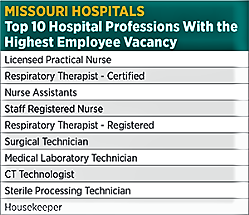JEFFERSON CITY — A new report from the Missouri Hospital Association finds that turmoil in the hospital workforce — including unprecedented levels of turnover and vacancy — presents a risk to care delivery and workforce sustainability. This threat is both immediate and long term.
“The pandemic was highly disruptive to the hospital workforce,” said Jon D. Doolittle, MHA President and CEO. “As we exited 2021, the indications of a full-blown crisis in hospital staffing were emerging. This year’s report includes several categories of essential front-line caregivers at record levels of vacancy. At the same time, many of the jobs that support hospital operations — housekeeping services and dietary aides, for example — were experiencing astronomical rates of turnover. These trends are more than unprecedented; they are unsustainable.”
Two categories of caregivers that were essential to COVID-19 response have among the highest rate of vacancy — nurses and respiratory therapists. The state’s top five professions for vacancy fall into this category. Three nursing positions — including staff registered nurse — are among the top five. Staff R.N.s make up the largest single cohort of hospital employees in Missouri. This year’s report finds staff R.N. vacancy rates at 19.8 percent — the highest in the 21-year history of the survey. Between the 2020 survey and 2022, there has been a 98 percent increase in all staff R.N. vacancies. Missouri has 33,692 staff R.N.s working in hospitals; 8,334 positions are listed as vacancies.
2022 Missouri Hospitals Top 10 Hospital Professions with the highest employee vacancy

Nursing is not the only clinical profession that has been influenced by the pandemic. RTs, who were at the front line of care during COVID-19, also are in short supply. Since 2020, vacancies have grown 90 percent for all certified RTs. These therapists care for the sickest patients, including patients placed on a ventilator.
“Hospitals’ staffing pressures are attributed to numerous factors,” Doolittle said. “These include, but are not limited to, burnout and fatigue from COVID-19, agency staff wage distortion in the hospital and attractive salaries for agency work within the state and nationally, and departures from the hospital workforce. It isn’t yet clear if time will mitigate these challenges.”
Hospitals are innovating to meet the short-term challenges. Strategies include reallocation and retraining of nurses and other personnel, reevaluation of the skill mix necessary to provide care, team-based and virtual care models, and career ladders and professional development opportunities. In addition, hospitals are using various tools to recruit, retain and reward staff. These strategies include financial incentives, new flexibility and support systems within the workplace, and personal wellness programs.
“Hospital employees deserve our support,” Doolittle said. “They have labored through two years of crisis and are continuing to work diligently to provide care for COVID-19 while addressing the pent-up demand for care that the pandemic created. As leaders, it is essential we recognize where our workers are in this journey, reward their hard work and build the systems we need to have a sustainable workforce in the future.”
Although the immediate challenge is maintaining operations and retaining the incumbent workforce, hospitals — and partners in government and academia — are focused on the future workforce, as well. This effort includes attracting career prospects into health professions while ensuring the workforce pipeline is adequate to train them academically and clinically.
Through MHA, hospitals support MissouriHealthCareers.com, and they work with stakeholders — from local guidance counselors and the Missouri Department of Elementary and Secondary Education to workforce development partners and the Missouri Chamber of Commerce and Industry — to build interest in health professions. In addition, MHA supports nurse mentoring to reduce turnover, and the Clinical Faculty Academy to support nurses with advanced nursing education participate as adjunct faculty at Missouri nursing schools.
“Hospitals and MHA have been partner-friendly in efforts to bridge the supply and demand gaps in the workforce,” Doolittle said. “Each hospital’s strategy will require a mix of approaches — from changes in culture and the care team, to innovative approaches for recruiting and retention. Likewise, every community has skin in the game. The ability to attract and retain talent will be a difference-maker in the viability of the health care system, access to care and the economic opportunities that link to a strong, local health care system — from primary care to hospital care.”
